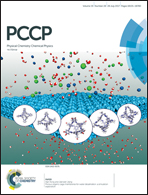Effect of the cation on the stability of cation–glyme complexes and their interactions with the [TFSA]− anion†
Abstract
The interactions of glymes with alkali or alkaline earth metal cations depend strongly on the metal cations. For example, the stabilization energies (Eform) calculated for the formation of cation–triglyme (G3) complexes with Li+, Na+, K+, Mg2+, and Ca2+ at the MP2/6-311G** level were −95.6, −66.4, −52.5, −255.0, and −185.0 kcal mol−1, respectively, and those for the cation–tetraglyme (G4) complexes were −107.7, −76.3, −60.9, −288.3 and −215.0 kcal mol−1, respectively. The electrostatic and induction interactions are the major source of the attraction in the complexes; the contribution of the induction interactions to the attraction is especially significant in the divalent cation–glyme complexes. The binding energies of the cation–G3 complexes with Li+, Na+, K+, Mg2+, and Ca2+ and the bis(trifluoromethylsulfonyl)amide anion ([TFSA]−) were −83.9, −86.6, −80.0, −196.1, and −189.5 kcal mol−1, respectively, and they are larger than the binding energies of the corresponding cation–G4 complexes (−73.6, −75.0, −77.4, −172.1, and −177.2 kcal mol−1, respectively). The binding energies and conformational flexibility of the cation–glyme complexes also affect the melting points of equimolar mixtures of glyme and TFSA salts. Furthermore, the interactions of the metal cations with the oxygen atoms of glymes significantly decrease the HOMO energy levels of glymes. The HOMO energy levels of glymes in the cation–glyme–TFSA complexes are lower than those of isolated glymes, although they are higher than those of the cation–glyme complexes.
![Graphical abstract: Effect of the cation on the stability of cation–glyme complexes and their interactions with the [TFSA]− anion](/en/Image/Get?imageInfo.ImageType=GA&imageInfo.ImageIdentifier.ManuscriptID=C7CP02779F&imageInfo.ImageIdentifier.Year=2017)
- This article is part of the themed collection: 2017 PCCP HOT Articles


 Please wait while we load your content...
Please wait while we load your content...